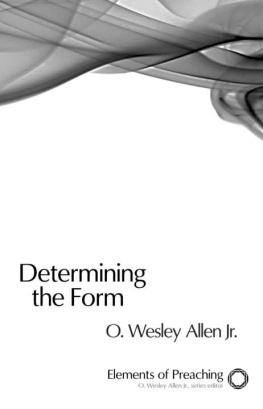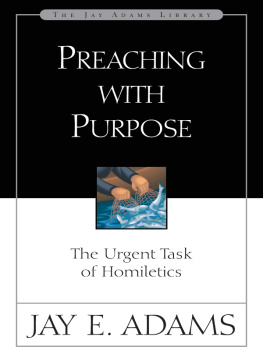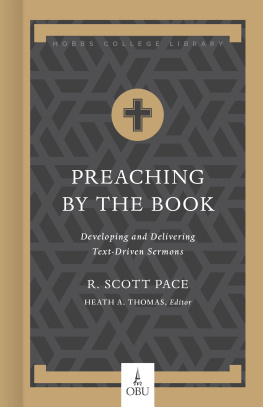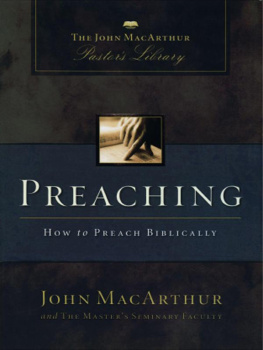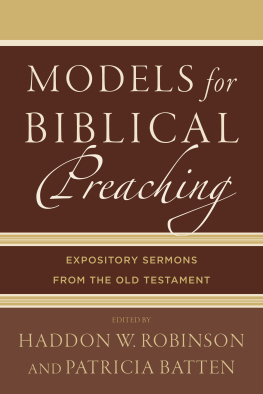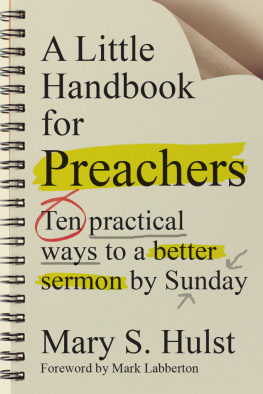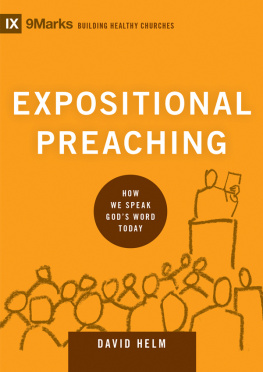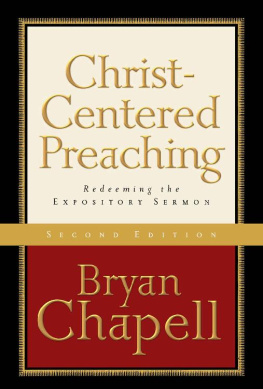Determining
the Form
Elements of Preaching
0. Wesley Allen Jr., series editor
Thinking Theologically
The Preacher as Theologian
Ronald J. Allen
Knowing the Context
Frames, Tools, and Signs for Preaching
James R. Nieman
Interpreting the Bible
Exegetical Approaches for Preaching
Mary F. Foskett
Shaping the Claim
Moving from Text to Sermon
Marvin A. McMickle
Determining the Form
Structures for Preaching
0. Wesley Allen Jr.
Finding Language and Imagery
Words for Holy Speech
Jennifer L. Lord
Delivering the Sermon
Voice, Body, and Animation in Proclamation
Teresa L. Fry Brown
Serving the Word
Preaching in Worship
Melinda A. Quivik
Determining
the Form
Structures for Preaching
0. Wesley Allen Jr.




Contents
Chapter 2
Chapter 3
Chapter 4
Chapter 5
Chapter 6
Chapter 7
Chapter 8
Chapter 9
Chapter 10
Illustrations
Editor's Foreword
Preparing beginning preachers to stand before the body of Christ and proclaim the word of God faithfully, authentically, and effectively Sunday after Sunday is and always has been a daunting responsibility. As North American pastors face pews filled with citizens of a postmodern, post-Christendom culture, this teaching task becomes even more complex. The theological, exegetical, and homiletical skills that preachers need for the future are as much in flux today as they have ever been in Western Christianity. Thus providing seminary students with a solid but flexible homiletical foundation at the start of their careers is a necessity.
Traditionally, professors of preaching choose a primary introductory textbook that presents a theology of proclamation and a process of sermon development and delivery from a single point of view. To maintain such a singular point of view is the sign of good writing, but it does at times cause problems for learning in pluralistic settings. One approach to preaching does not fit all. Yet a course simply surveying all of the homiletical possibilities available will not provide a foundation on which to build either.
Furthermore, while there are numerous introductory preaching textbooks from which to choose, most are written from the perspective of Euro-American males. Classes supplement this view with smaller homiletical texts written by women and persons of color. But a pedagogical hierarchy is nevertheless set up: the white male voice provides the main course and women and persons of color provide the side dishes.
Elements of Preaching is a series designed to help professors and students of preaching-including established preachers who want to develop their skills in specific areas-construct a sound homiletical foundation in a conversational manner. This conversation is meant to occur at two levels. First, the series as a whole deals with basic components found in most introductory preaching classes: theology of proclamation, homiletical contexts, biblical interpretation, sermonic claim, language and imagery, rhetorical form, delivery, and worship. But each element is presented by a different scholar, all of whom represent diversity in terms of gender, theological traditions (Baptist, Disciple of Christ, Lutheran, Presbyterian, and United Methodist), and ethnicity (African American, Asian American, and Euro-American). Instead of bringing in different voices at the margin of the preaching class, Elements of Preaching creates a conversation around the central topics of an introductory course without foregoing essential instruction concerning sermon construction and embodiment. Indeed, this level of conversation is extended beyond the printed volumes through the Web site www.ElementsofPreaching.com.
Second, the individual volumes are written in an open-ended manner. The individual author's particular views are offered but in a way that invites, indeed demands, the readers to move beyond them in developing their own approaches to the preaching task. The volumes offer theoretical and practical insights, but at the last page it is clear that more must be said. Professors and students have a solid place to begin, but there is flexibility within the class (and after the class in ministry) to move beyond these volumes by building on the insights and advice they offer.
In this volume, 0. Wesley Allen Jr. presents the challenge preachers face of choosing the rhetorical shape of the Sunday sermon week after week. Having determined what the text says, what the congregation needs to hear, and what she wants to say, the preacher must decide how to say it. A major element of this involves determining the form of the sermon, the ordering of ideas and imagery designed to convey a specific gospel message and offer a particular experience of that message to a particular congregation. The book begins with the foundational matters of why form must be consciously considered instead of intuitively developed and the basic elements of any form. The bulk of the volume, however, is a survey of various forms preachers have found effective over the years. Allen's survey is representative, not exhaustive. The collection is intended to provide a variety of approaches that beginning preachers can master and experienced preachers can use to expand their homiletical repertoire.
0. Wesley Allen Jr.
Acknowledgments
As editor of the Elements of Preaching series, it is tempting to use this opportunity to thank those who have supported the work of and contributed to the series in general instead of simply naming those who gave me aid in the writing of this specific volume. But in truth the distinction is flawed. The conversations I have had with other authors in the series-Ron Allen, James Nieman, Mary Foskett, Marvin McMickle, Jennifer Lord, Teresa Fry Brown, and Melinda Quivik-along with the reading I have done of those volumes that have preceded mine have influenced the approach and tone I have used in this volume in too many ways to name. They are some of the finest scholars and teachers I know and my work is better for trying to keep up with them. In addition, Ron Allen gave insightful feedback concerning my initial take on the task of teaching sermonic form, and David Lott, who edits all of the Elements volumes for Fortress, has been an invaluable conversation partner throughout the whole project. And I would be remiss if I failed to name the constant support I receive in this and all my work from my wife Bonnie and daughter Maggie.
Perhaps because of the introductory nature of this volume, I have, more than with any prior writing project, felt myself surrounded by a cloud of witnesses who have not only shared their faith and thoughts with me but have taught me to preach and taught me to teach preaching. Earl Gossett, Bill Muehl, Harry Adams, Fred Craddock, and Gail O'Day were my professors. Heather Murray Elkins, Jan Dunnavant, Lisa Davison, and Bill Kincaid have cotaught with me. And students from a range of backgrounds and with an array of vocational goals have sat with me in preaching classes at Drew Theological School and Lexington Theological Seminary while we explored ways to proclaim the most significant aspect or experience of God's forgiving and demanding presence in conversation with diverse congregations in diverse contexts. All three groups-professors, colleagues, and students-have taught me much about the task of proclamation. I dedicate this book to them, and pray that its publication may bring me into an even wider circle of sisters and brothers in Christ who can teach me yet more about the call not simply to preach the Word, but to effect a hearing of the Word.

